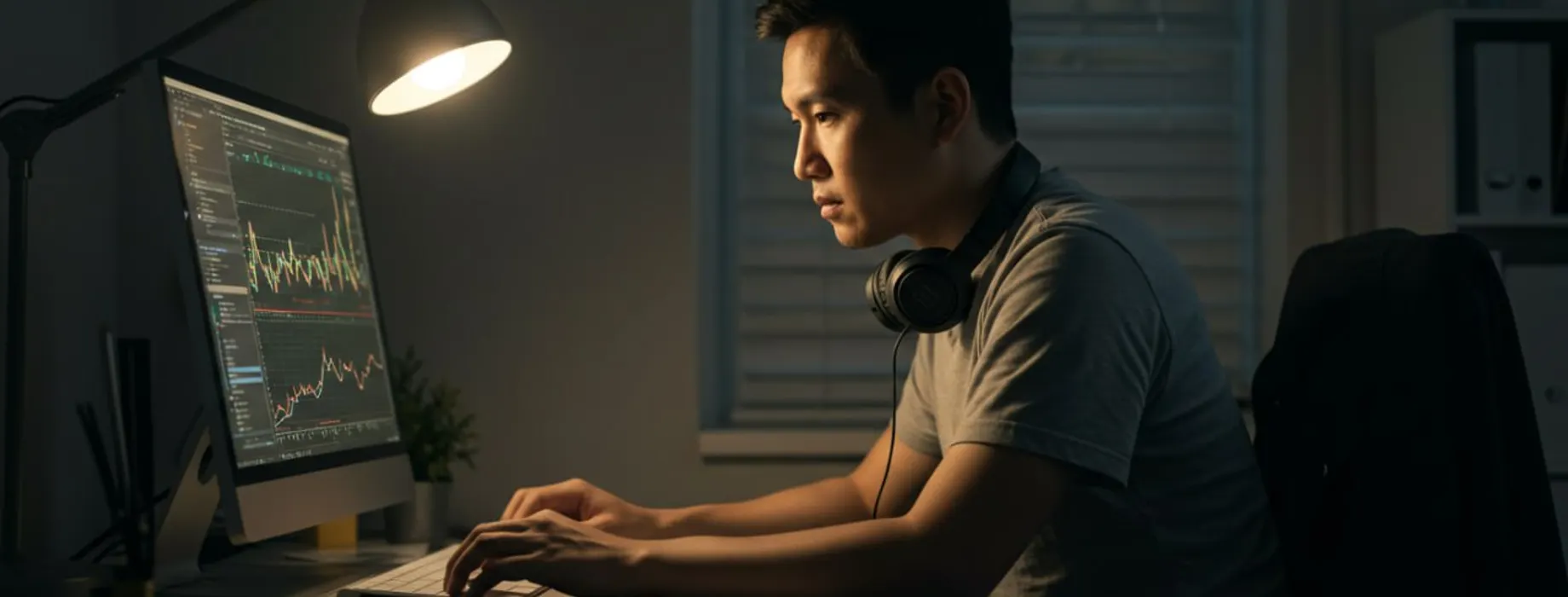- What to actually expect when day trading with $1000
- How to choose the right market and strategy
- How to manage risk without blowing up
- And how to grow — not gamble — your capital
Day Trading with $1000: Realistic Expectations and Strategies

Everyone wants to flip a small trading account into something big. The internet is full of stories — some real, most exaggerated — of traders turning $1000 into $10,000 “in a few weeks.”
But here’s the truth: starting with $1000 is possible, but it takes a specific mindset, tight discipline, and realistic goals.
This article isn’t about overnight riches. It’s a grounded guide to:
Whether you’re using Forex, binary options, or crypto — this guide will help you build from $1000 the right way.
It’s tailored for those focused on day trading with small account setups who want structure instead of hype.
💰 What Can You Expect from $1000?
Let’s get one thing straight — $1000 is not a shortcut to quitting your job. When it comes to $1000 trading, the goal isn’t instant success — it’s survival, learning, and gradual scaling. But it is a great place to start learning how the market really works, without risking your financial stability.
🧱 What $1000 Can’t Do:
- It won’t generate “life-changing” profits in a month
- It won’t allow you to make large, diversified trades
- It won’t protect you from mistakes — every loss will feel big
✅ What $1000 Can Do:
- Teach you discipline
- Give you skin in the game
- Help you test real strategies with real money
- Let you experience the psychology of trading without going broke
The goal isn’t to turn $1000 into $10,000 overnight — it’s to avoid turning $1000 into $0 in a week.
With the right mindset, that $1000 can be the foundation of real growth — not just financially, but in your skills and habits as a trader.
🧠 Psychological Shifts You Need
Trading a $1000 account isn’t about “making it” — it’s about surviving long enough to learn.
The hardest part of growing a small account isn’t the technical strategy — it’s your mindset.
🔁 Shift #1: Think in Percentages, Not Dollars
Making $10 on a $1000 account is a 1% gain — and that’s great.
Chasing $100 per trade is how people blow accounts in 3 days.
📉 Shift #2: Small Losses Are Wins Too
Avoiding a bad trade and keeping your capital intact is a strategic success, even if you didn’t “make money” that day.
📊 Shift #3: Your Goal Is Consistency, Not Speed
If you can make 2–4% per week — you’re already ahead of 90% of beginners. Let compound growth, not desperation, be your engine.
Small accounts magnify emotion. One bad trade feels like the end of the world. One good trade makes you think you’ve mastered the market. Neither is true.
Discipline > excitement. Structure > instinct. And patience? It’s everything.
⚙️ Choosing the Right Market for Small Accounts
Not all markets are friendly to $1000 traders. With limited capital, you need low barriers to entry, tight cost control, and clear position sizing.
Here’s how major markets stack up:
💱 Forex (Foreign Exchange)
- Micro-lot trading allows small risk per position
- High liquidity, 24/5 trading
- Beware of over-leveraging — small accounts disappear fast if misused
📊 Binary Options (e.g., Quick Trading on Pocket Option)
- Fixed risk per trade (perfect for small accounts)
- Short-term setups with known expiration
- No slippage, no spread
- You must be precise — timing is everything
🪙 Crypto & CFDs
- 24/7 access, high volatility
- High fees on small trades (especially on low-volume coins)
- Can be dangerously leveraged without clear stop tools
🧭 Best Choice for Beginners?
Binary options and Forex micro-lots are the most accessible for $1000 traders. These markets are especially useful for managing beginner trading capital, giving new traders control and clear parameters. Binary platforms offer:
- Entry from as low as $1 per trade
- Built-in risk caps
- Mobile and desktop access with real-time indicators
Small account = small margin for error. Choose markets that give you control, clarity, and cost-efficiency.
📈 Small Account Strategies That Actually Work
You don’t need a complicated system to grow a $1000 account — but you do need a disciplined, repeatable setup. Below are strategies that work well with limited capital.
🎯 1. Scalping with Tight Stops
- Works best on Forex or crypto
- Use micro-lots to manage risk (0.01–0.02 lot sizes)
- Target 1:2 or 1:3 setups (e.g., $10 risk for $20–30 gain)
- Only 1–2 trades per session — quality over quantity
⚡ 2. Price Action Timing
- Trade short-term setups (60s–5m) on Pocket Option
- Focus on key support/resistance zones
- Combine with candlestick confirmation (e.g., pin bar, engulfing)
- Control exposure: no more than 1–2% per trade
🧱 3. Breakout and Retest Entries
- Wait for breakout of key level
- Enter only on clean retest with volume or candle confirmation
- Use fixed SL/TP or short expiry (5m on Pocket Option)
- Avoid fakeouts by trading only during liquid sessions (e.g., London/New York overlap)
🧠 4. The “One-Setup Strategy” Rule
Stick to one setup until you’re consistent.
Trying 5 systems with $1000 will teach you nothing. Master one — then scale.
In a small account, your greatest edge isn’t leverage — it’s selectivity. Trade less, filter more, and let consistency compound your growth.
⚠️ Risk Management for a $1000 Account
Small accounts don’t survive bad habits. One oversized trade, and you’re done. Risk management is not optional — it’s the strategy.
💡 Golden Rules
- Risk 1–2% max per trade → $10–$20
- 1–3 trades per day max
- Use fixed expiration (in binaries) or tight SL (in Forex)
- No martingale, no doubling down
📊 Risk/Reward Scenarios Table
| Trade | Outcome | Risked (1.5%) | Win (2:1 R:R) | Loss | Account After |
|---|---|---|---|---|---|
| Trade 1 | WIN | $15 | +$30 | — | $1030 |
| Trade 2 | LOSS | $15 | — | -$15 | $1015 |
| Trade 3 | WIN | $15 | +$30 | — | $1045 |
Even with 1 loss out of 3, you grow.
It’s not about winning every trade — it’s about surviving every session.
🧠 Pocket Option Tip
Set your default trade size and daily risk limit. This helps prevent over-trading or revenge moves.
Small account growth is like planting seeds. You don’t dig them up every day — you water them consistently.
📊 Example: Weekly Plan for $1000 Day Trader
Consistency beats intensity. Here’s what a realistic week could look like for a small account trader, focusing on controlled risk and planned entries.
🗓 Sample Weekly Structure (Risk per trade: $10–15)
| Day | Objective | Max Risk | Focused Setup | Notes |
|---|---|---|---|---|
| Monday | Market scan & prep | $0 | No trades — analyze zones | Save capital, define key levels |
| Tuesday | High-prob entry | $15 | Breakout w/ confirmation | 1–2 trades max |
| Wednesday | Continuation or fade | $15 | Pullback on trendline | Trade only if setup aligns |
| Thursday | Volatility setup | $10 | News-based reversal | Avoid overtrading post-news |
| Friday | Review & journal | $0 | No trades — analysis only | Track % return, not $ gains |
🧠 Notes:
- If no good setup = no trade
- Max weekly risk = ~$45–60 (4.5–6% total)
- Focus on setups that repeat, not “big wins”
Trading with $1000 isn’t about doing more — it’s about doing less with precision.
🧾 Conclusion
Starting with $1000 won’t make you rich overnight — but it can make you disciplined, skilled, and prepared for real growth.
If you treat every dollar like capital — not gambling chips — you’ll trade smarter, take fewer losses, and build a long-term edge.
Grow slow. Trade clean. Think in % — not promises.
📚 Sources & References
- Pocket Option – Small Account Trading Features www.pocketoption.com
- BabyPips – Risk Management for Small Accounts www.babypips.com
- Investopedia – Day Trading Basics www.investopedia.com
- CFA Institute – Behavioral Finance in Low Capital Trading www.cfainstitute.org
FAQ
Can I turn $1000 into a full-time income?
Not right away. With smart risk and solid strategy, you can build consistency — but $1000 is more of a training ground than a paycheck.
How much can I realistically make per month?
If you average 5–10% monthly, that’s already excellent. That’s $50–$100/month — the goal is skill-building, not speed.
What if I lose 50% of my account?
Stop trading. Re-evaluate your strategy and mindset. It’s not the money — it’s the mistake that needs fixing.
Can I trade on mobile?
Yes. Platforms like Pocket Option are mobile-optimized, with fast execution and small position sizes — perfect for small accounts and flexible routines.
